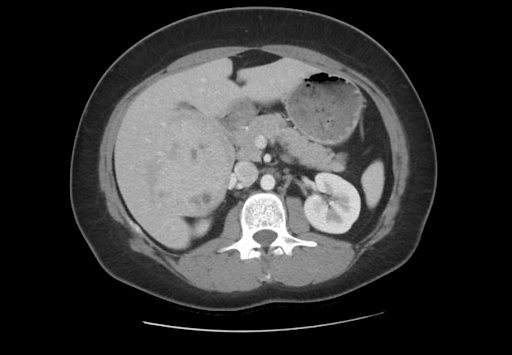Sunday Poster Session
Category: Liver
P1793 - A Rare Occurrence of Hepatocellular Carcinoma in a Younger Female Patient
Sunday, October 26, 2025
3:30 PM - 7:00 PM PDT
Location: Exhibit Hall

Brice Gorman (he/him/his)
University of Alabama
Tuscaloosa, AL
Presenting Author(s)
Brice Gorman, 1, Connor Paine, BS, BA2, Fletcher Hesse, 3, Sphurti Neelam, BS3, Shabarnadh Gangireddy, MBBS4, Adisesha Reddy, MD, FACG3, Robert M. Cannon, MD5
1University of Alabama, Tuscaloosa, AL; 2University of Alabama, Florence, AL; 3GastroCare P.C., Tuscaloosa, AL; 4Narayana Medical College,Nellore, Des Moines, IA; 5University of Alabama at Birmingham, Birmingham, AL
Introduction: Hepatocellular carcinomas (HCCs) are malignant tumors arising from mutations within normal hepatocytes. Over 80% of cases present in patients greater than or equal to 55 years of age with the incidence rates significantly dropping in younger patients1. Additionally, cases often present with abnormal alpha-fetoprotein levels. We present a case of a large, well differentiated, hepatocellular carcinoma presenting in a younger female patient with normal liver test values.
Case Description/
Methods: A 25 year old female presents with a history of several years of progressive abdominal pain, nausea with vomiting, easy fatigability, loss of appetite, and dyspnea upon exertion. The patient had a 10 year history of oral contraceptive (OCP) use. CT and MRI of the abdomen showed a complex mass measuring 9.1 x 7.2 x 7.2 cm within the right medial lobe of the liver. AST, ALT and alpha fetoprotein levels were normal. OCPs were discontinued after the discovery of the mass, and the patient underwent portal vein embolization prior to a right partial hepatectomy. Upon histological analysis of the removed mass, reticulin stain was lost, supporting a final diagnosis of hepatocellular carcinoma. Additionally, glypican-3 was absent and Ki-87 was not increased.
Discussion: Although incidence of hepatocellular carcinoma is highest in patients 55 and older1, it can present in younger patients without history of liver disease. Indications may begin with generalized symptoms, such as abdominal pain or weight loss, and can worsen over time. Additionally, patients with HCCs often show elevated alpha fetoprotein, however, liver function tests can return with normal values. Therefore, although rare, hepatocellular carcinoma should be included in the differential diagnosis of liver mass cases, even in younger patients with normal liver panels.
1 Abboud Y, Ismail M, Khan H, et al. Hepatocellular Carcinoma Incidence and Mortality in the USA by Sex, Age, and Race: A Nationwide Analysis of Two Decades. J Clin Transl Hepatol. 2024;12(2):172-181. doi:10.14218/JCTH.2023.00356

Figure: CT of the abdomen showing the mass with liver involvement.
Disclosures:
Brice Gorman indicated no relevant financial relationships.
Connor Paine indicated no relevant financial relationships.
Fletcher Hesse indicated no relevant financial relationships.
Sphurti Neelam indicated no relevant financial relationships.
Shabarnadh Gangireddy indicated no relevant financial relationships.
Adisesha Reddy indicated no relevant financial relationships.
Robert Cannon: Transmedics – Grant/Research Support.
Brice Gorman, 1, Connor Paine, BS, BA2, Fletcher Hesse, 3, Sphurti Neelam, BS3, Shabarnadh Gangireddy, MBBS4, Adisesha Reddy, MD, FACG3, Robert M. Cannon, MD5. P1793 - A Rare Occurrence of Hepatocellular Carcinoma in a Younger Female Patient, ACG 2025 Annual Scientific Meeting Abstracts. Phoenix, AZ: American College of Gastroenterology.
1University of Alabama, Tuscaloosa, AL; 2University of Alabama, Florence, AL; 3GastroCare P.C., Tuscaloosa, AL; 4Narayana Medical College,Nellore, Des Moines, IA; 5University of Alabama at Birmingham, Birmingham, AL
Introduction: Hepatocellular carcinomas (HCCs) are malignant tumors arising from mutations within normal hepatocytes. Over 80% of cases present in patients greater than or equal to 55 years of age with the incidence rates significantly dropping in younger patients1. Additionally, cases often present with abnormal alpha-fetoprotein levels. We present a case of a large, well differentiated, hepatocellular carcinoma presenting in a younger female patient with normal liver test values.
Case Description/
Methods: A 25 year old female presents with a history of several years of progressive abdominal pain, nausea with vomiting, easy fatigability, loss of appetite, and dyspnea upon exertion. The patient had a 10 year history of oral contraceptive (OCP) use. CT and MRI of the abdomen showed a complex mass measuring 9.1 x 7.2 x 7.2 cm within the right medial lobe of the liver. AST, ALT and alpha fetoprotein levels were normal. OCPs were discontinued after the discovery of the mass, and the patient underwent portal vein embolization prior to a right partial hepatectomy. Upon histological analysis of the removed mass, reticulin stain was lost, supporting a final diagnosis of hepatocellular carcinoma. Additionally, glypican-3 was absent and Ki-87 was not increased.
Discussion: Although incidence of hepatocellular carcinoma is highest in patients 55 and older1, it can present in younger patients without history of liver disease. Indications may begin with generalized symptoms, such as abdominal pain or weight loss, and can worsen over time. Additionally, patients with HCCs often show elevated alpha fetoprotein, however, liver function tests can return with normal values. Therefore, although rare, hepatocellular carcinoma should be included in the differential diagnosis of liver mass cases, even in younger patients with normal liver panels.
1 Abboud Y, Ismail M, Khan H, et al. Hepatocellular Carcinoma Incidence and Mortality in the USA by Sex, Age, and Race: A Nationwide Analysis of Two Decades. J Clin Transl Hepatol. 2024;12(2):172-181. doi:10.14218/JCTH.2023.00356

Figure: CT of the abdomen showing the mass with liver involvement.
Disclosures:
Brice Gorman indicated no relevant financial relationships.
Connor Paine indicated no relevant financial relationships.
Fletcher Hesse indicated no relevant financial relationships.
Sphurti Neelam indicated no relevant financial relationships.
Shabarnadh Gangireddy indicated no relevant financial relationships.
Adisesha Reddy indicated no relevant financial relationships.
Robert Cannon: Transmedics – Grant/Research Support.
Brice Gorman, 1, Connor Paine, BS, BA2, Fletcher Hesse, 3, Sphurti Neelam, BS3, Shabarnadh Gangireddy, MBBS4, Adisesha Reddy, MD, FACG3, Robert M. Cannon, MD5. P1793 - A Rare Occurrence of Hepatocellular Carcinoma in a Younger Female Patient, ACG 2025 Annual Scientific Meeting Abstracts. Phoenix, AZ: American College of Gastroenterology.
